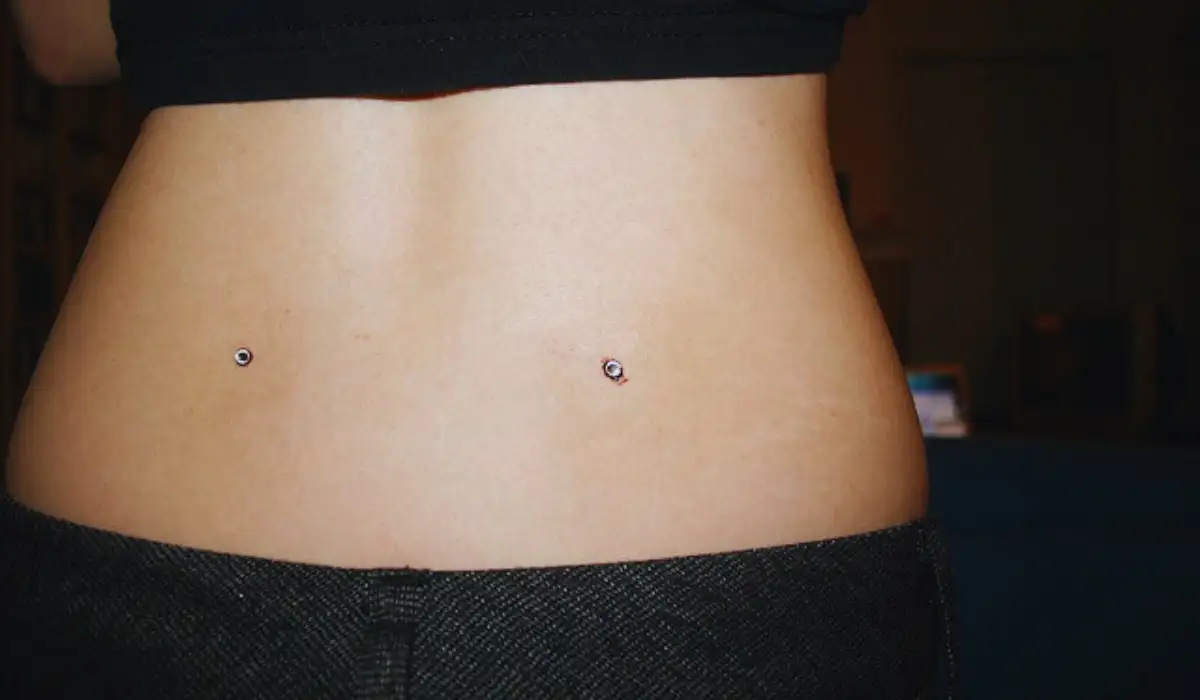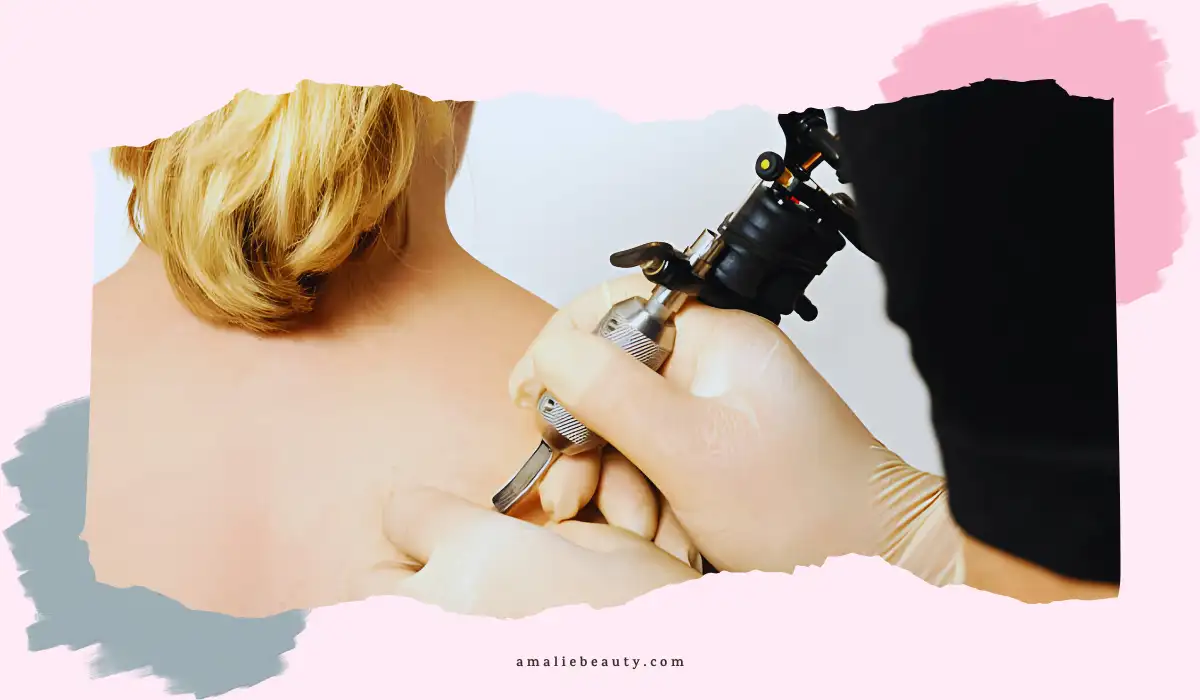Individuals around the world choose to get tattoos and piercings on their bodies. Some might do it for aesthetics, and some do it for their hobby; the choice depends on individual character and preferences. Anyway, the thing that makes back dermal piercings popular among youngsters is that they look quite elegant and cool, especially for women.
Although it might have some disadvantages, people still prefer to get them. So, covering all that, let’s dig deeper into all the information I’ve collected on these back dermal piercings.
What Is A Back Dermal Piercing?

So, if you’re considering a back dermal piercing for an aesthetic look, well, you might want to know some deeper details about it. The word ‘Dermal’ in the back dermal piercing means it will be inserted deeper into your epidermal layer of skin.
Sometimes, people would want to get a surface piercing while terming it a dermal one, which might get complicated during the procedure.
Back dermal piercing usually has two parts, a base and a crown, from which the base part goes under your skin, and the crown is attached to a gem and hangs outside.
When you get these piercings done, your piercer will make an incision for each one. Though it might not be a pleasureful situation, the pain can differ according to your pain tolerance level.
In addition to that, there are certain symptoms and drawbacks of getting these piercings, which might affect your daily life afterward. So, consider all the terms I’ve mentioned before getting one for yourself.
Which Materials Are Used In Back Dermal Piercing?
As I’ve mentioned before, there are two parts of back dermal piercing: a base and a crown. So, the crowns are of multiple different types and can either be plain metal or can even be attached with gems.
Even when you are getting the simplest piercings, the procedure is usually the same, so it doesn’t matter what gem or material you choose for yourself.
When you are getting the piercing, the materials used as the base are usually surgical-grade stainless steel, platinum, or niobium. Now, for the crown, individuals consider getting gold, diamonds, and other precious stones as per their preferences.
If you have sensitive skin or you are prone to allergies or irritation, you should choose titanium for your back dermal piercing material. On the other hand, if you are free from those issues, you can get a gold one, they usually come in 14-carat yellow or white type.
Make sure you’re not going higher than 18-caret gold crowns, as they are less durable and can easily get damaged.
Risk Factors Of Getting A Back Dermal Piercing
When it comes to the downside of back dermal piercing, there are some you might want to know before you are getting on for yourself. From rejection to nerve damage, anything can happen if the piercing is done carelessly.
So, when you get your back dermal piercing done, there is a slim chance that your body might think of it as a foreign material and reject it by pushing it out slowly. This can lead to improper placement and painful experiences due to it as well.
Another risk factor of getting back dermal piercing is that it can cause infection in your skin’s epidermal layer. This doesn’t happen in general, but in case your piercer puts the base of your piercing improperly or exposes it to the air, it can cause infection.
For nerve damage, getting a back dermal piercing can also make it happen. If your piercing is placed too deep in your epidermal layer, it can impact your tissues or nerves and damage them.
Is The Piercing Painful During the Procedure?
If you are asking, will it hurt when someone cuts through your skin and places a metal inside its surface? So, yes, it definitely will hurt, but it depends on your pain tolerance, so the pain might be low in your case if you can manage it.
The procedure consists of making an incision for each one of your back dermal piercings, so it should be sanitized and shouldn’t cause any infection.
Some individuals say that during the procedure, they only felt a pinch and nothing else. So, the main generally depends on your tolerance, and if you can’t handle the pain, you should discuss it with your piercer in advance.
How To Get A Back Dermal Piercing Removal?
So, you’re considering a back dermal piercing removal, which is also a surgical procedure and should be done under observation. Anyway, dermal piercings are quite plunged under your skin and can last for several years. However, in some cases, it can get displaced or come out of your skin on its own, which is usually painless.
When you are getting a back dermal piercing removed, your piercer will most likely do the following:
- Sterilize the area around your piercings.
- Then, they might unscrew the top or crown attached to the gems.
- After that, they might massage the surrounding area to get the base in place.
- Then, a small incision would be made, and the piercing bases would be taken out.
- At the end of the procedure, your piercer will suture or close the incision carefully.
Although the procedure can be a simple task for many piercers, make sure you are getting them removed by your doctor or expert surgeons. And, in no circumstances should you be pulling your piercings out yourself, as it can damage a lot more than you might expect.
Should You Talk To An Expert Before Getting Back Dermal Piercing?
Well, getting a back dermal piercing is a surgical procedure, and you must take expert advice. Usually, people ask experts and piercers about the back dermal piercing price, which most likely depends on the piercer you are getting them from or the material you are choosing for your crowns.
In addition to that, make sure you take care of your piercings after getting them done; it can help you make them long-lasting and durable for years to come.
Conclusion
In conclusion, anyone thinking about getting a back dermal piercing or who already has one needs to understand the removal procedure. People can remove their dermal piercings safely and maintain ideal skin health by speaking with a professional and adhering to the recommended aftercare instructions.
References
- Tattoos and piercing. (2014).
https://www.girlshealth.gov/body/grooming/tattoo_pierce.html - Yu CHY, et al. (2010). Bacterial infections complicating tongue piercing.
https://www.ncbi.nlm.nih.gov/pmc/articles/PMC2852294/

